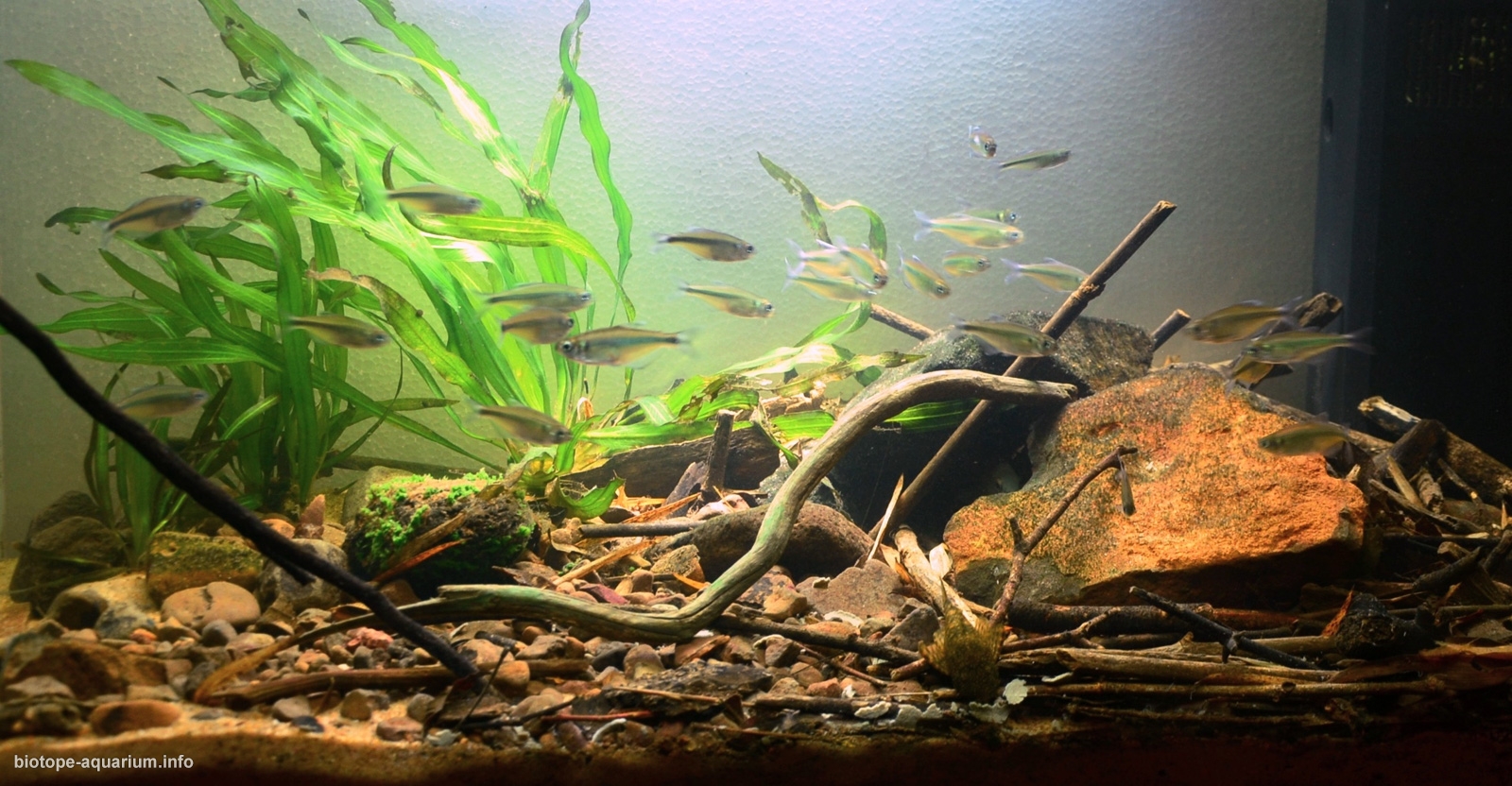Fortaleza Creek, Uruguay River Basin, Misiones, Argentina
41st place in Biotope Aquarium Design Contest 2017
![]() Argentina. Philip Cortesi
Argentina. Philip Cortesi

Volume: 153 L
Dimensions: 85x45x40 cm
List of fishes: Crenicichla minuano, Cyanocharax uruguayensis, Ancistrus sp. “Fortaleza Creek”,
List of plants: Echinodorus bleherae
Description of decorations: Sand, stones from 1mm – 20cm native, drift wood native, leaves native; some plants to hide and give green tones, a cave to breed crenicichla made with stones, some wood as in nature, space to swim for Cyanochrarax.
Description of equipment: 1 x Juwel Filter 300 lph, 1 x Atman Filter 600 lph, 2 x T5 36W light (7500K), 1 x Juwel 50W heater (set to 24°)
Water parameters: PH = 7.1, dGH: 0.00 – 3.00, Temperature = 26°
Description of the area surrounding the biotope: The Fortaleza creek is located between Facran and San Pedro villages in the province of Misiones in Argentina. The level above sea is near to 600 meters. The climate is humid and subtropical with abundant rainfall throughout the year. The Fortaleza creek, and this biotope, are situated on the top of Misiones central hills, surrounded by dense jungle on the lower part. The creek is only accessible by human at the top. There is small waterfall which is an important natural barrier for many aquatic species. At this point (26°46’01.7″S 54°10’46.9″W) is where the jungle is less dense but still remarkable and highly important for the bio-habitat and the underwater-life. Pompous native trees and huge stones are covered by bushes, plants, ferns, mosses and result into a kind of paradise-looking landscape. The creek is about 5 to 11 meters bright.
Description of the underwater landscape of the biotope: The underwater landscape is unique. The water is quite clear at sunny days. High concentration of oxygen and an average temperature of 24° are good conditions for a big amount of plants, invertebrates and exotic fish. From small Astyanax to cichlids, wolf and cat fish, together they life in peaceful harmony. The amount of species is high! The bottom consist of lateritic soil, covered sand, small and big stones and fallen wood and leaves from native trees. There are some parts with rapid flowing streams and some sand banks with slow flow and a lot of drift wood. The average deepness should be near to 0.50 meters. Do not surprise if you find an entire fallen tree in the water! When it rains the conditions change rapidly. The water flow can increase into dangerous levels for human and the water gets red-turbid. This phenomenon is absolutely natural and is be part of the ecosystem. New fertilize soil and rainwater allow new life for millions of aquatic habitants.
Description of the parameters of the habitat: The water of the creek is a combination of natural water sources bubbling from the ground and rainwater. Mixed, the parameters move around: PH 7.3, GH 5.5, KH 6, Conductivity 31 µS×cm-1. (I did the measurement by myself at the creek with a hobby Test Set during a sunny day, water level low, September 2017).
List of fishes: Australoheros ykeregua (Říčan, Piálek, Almirón & Casciotta, 2011), Gymnogeophagus lipokarenos (Malabarba, Malabarba & Reis, 2015), Crenicichla missioneira (Lucena & Kullander, 1992), Crenicichla minuano (Lucena & Kullander, 1992), Cyanocharax uruguayensis (Messner, 1962), Astyanax dissimilis (Baumgartner et al., 2012), Oligosarcus amome (Almirón et al., 2015), Astyanax paris (Azpelicueta, Almirón & Casciotta, 2002), Astyanax sp. “Arroyo Fortaleza“, Ancisturs sp. “Arrroyo Fortaleza“, Lorircaria sp. “Arroyo Fortaleza“, Epactionotus aky (Azpelicueta, Casciotta, Almirón & Körber, 2004), Leoprinus amae (Godoy, 1980), Hoplias malabaricus (Bloch, 1794), Synbranchus sp. “Arroyo Fortaleza“, Pimelodus mustelinus (Valenciennes, 1835), Aegla platensis (Schmitt, 1942), Trichodactylus Kensleyi (Rodríguez, 1992), Dytiscidae sp. (larva), Trichoptera sp. (larva).
List of plants: Echinodorus bleherae (Rataj 1970) (abundant), Podostemum sp. “Arroyo Fortaleza“, Marchantia polymorpha and mosses (mostly submerged on soil rocks).
Sources of information:
- Peces Criollos (Website)
http://www.pecescriollos.de/go/home/lang=EN - Revista Mexicana de Biodiversidad / ISSN: 1870-3453
Fish diversity and community structure of Yabotí stream, Yabotí Biosphere Reserve, Misiones, Argentina
http://www.redalyc.org/pdf/425/42539890009.pdf - CLOFFAR – update 3
Ichthyological Contributions of PecesCriollos 47
https://media.hotelwebservice.com/media/pecescriollos/docs/ icp_47_-_koerber_et_al_2017_ cloffar_-_update_3.pdf - Phylogenetic relationships of species of Crenicichla (Teleostei: Cichlidae) from southern South America based on the mitochondrial cytochrome b gene
https://www.researchgate.net/publication/229970602 - The Crenicichla (Teleostei: Cichlidae) species of the Uruguai River drainage in Brazil
https://www.researchgate.net/publication/281605595 - Two new species of Australoheros (Teleostei: Cichlidae), with notes on diversity of the genus and biogeography of the Río de la Plata basin
https://www.researchgate.net/publication/228814635 - Hyphessobrycon melanopleurus uruguayensis Messner, 1962, an available name and a senior synonym of Cyanocharax macropinna Malabarba & Weitzman, 2003 (Ostariophysi: Characidae)
https://www.researchgate.net/publication/242251435 - First record of Gymnogeophagus lipokarenos Malabarba, Malabarba & Reis, 2015 (Teleostei: Cichliformes) from Argentina.
https://www.researchgate.net/publication/318710858 - A new species of Otothyrini (Siluriformes: Loricariidae: Hypoptopomatinae) from the Río Uruguay basin, Argentina
https://www.researchgate.net/publication/272942810 - First record and supplementary description of Leporinus amae Godoy, 1980 (Characiformes: Anostomidae) from freshwaters in Argentina
https://www.researchgate.net/publication/266023545 - Oligosarcus amome (Ostariophysi: Characidae), a new species from the rio Uruguay basin, Misiones, Argentina
https://www.researchgate.net/publication/272098856 - Revista Mexicana de Biodiversidad / ISSN: 1870-3453
Fish diversity and community structure of Yabotí stream, Yabotí Biosphere Reserve, Misiones, Argentina
http://www.redalyc.org/pdf/425/42539890009.pdf - Insectos Acuáticos. L. Buffa. Cátedra de Entomología. Fac. Cs. Ex. Fís. y Nat. UNC
http://www.efn.uncor.edu/departamentos/divbioeco/ entomo/acuaticos.pdf - https://aqua-aquapress.com
- http://www.datz.de/
- https://de.aqua-fish.net/
artikel/
